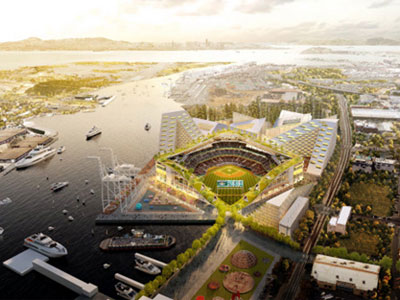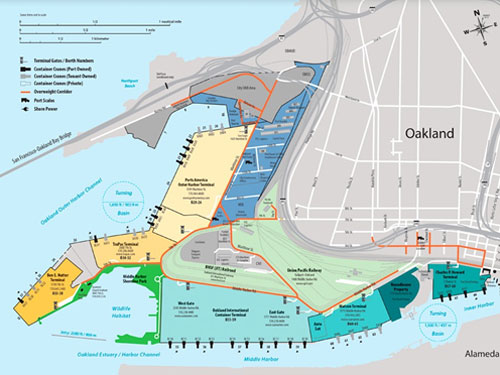The proposed Oakland Athletics baseball park to be located at the Port of Oakland (See rendering) is drawing criticism and opposition from maritime stakeholders, but a spokesman for the Oakland Athletics says that many of the industry’s concerns can be addressed.
Taj Tashombe, Vice President External Affairs for the Oakland A’s, outlined remedies to the Propeller Club of Northern California board of directors at a January 18th meeting:

The team is also looking at the construction of a gondola and a tram system to transport baseball fans to and from outlying parking lots to the ballpark. This will reduce passenger car traffic impacting harbor trucking.
The team is attempting to mitigate the glare from baseball park lights for the ship pilots and captains maneuvering vessels to and from nearby piers during night games. The team is looking at switching from older technology lighting to lower glare and energy generating LED lights. Lighting from the ballpark at night has been cited as a navigational hazard by ship pilots. The team will also explore whether LED lights interfere with the radio frequencies used by pilots and vessel officers on ships.
The team is meeting with the Oakland Police Department and the U.S. Coast Guard to find ways to control kayakers accessing the Oakland Estuary ship channel adjoining the proposed ballpark. Ship pilots worry that small boats and kayakers could disrupt the docking of ships during baseball games.
Most significantly, the A’s “would be willing to relinquish some of the 55 acres we will be leasing to provide the space to accommodate a wider turning basin” that adjoins Howard Terminal, Tashombe said. In order to stay competitive, the Port of Oakland is supporting the acquisition of newer and bigger container cranes to load and unload mega-container ships with an 18,000 teu (twenty-foot container) capacity at the nearby Oakland International Container Terminal. In addition, the Port will need to widen the turning basin to accommodate the bigger ships. Tashombe said that while the A’s are willing to support the wider turning basin by giving up some land, they need a detailed plan from the Port detailing costs and timelines: “We need to know what the Port’s plan is.”
Port’s Turning Basin Plans
Port of Oakland Marine Director John Driscoll told AJOT that widening the turning basin may be critical to handling mega container ships of 18,000 teus at Oakland International Container Terminal (OICT). OICT is the Port’s biggest container terminal and so the berthing of the bigger ships is crucial at this terminal. Right now, he says the biggest ships that can be serviced at the Port have a 14,000 teu capacity and are about 1,200 feet long.
The Port is also researching the possibility of widening the turning basin adjoining OICT to provide sufficient width in the Oakland Estuary for the big ships to turn around and berth:
“We forecast that these 18,000 teu ships will be coming within two to five years. Right now, the turning basis isn’t big enough. These are1,300-foot-long ships and they cannot turn around… So, we are engaging with the Army Corps of Engineers and doing some simulations as to what the next step is… The best step might be to widen the turning basin. If that is the case, the permit process could take from 5-10 years and so we need to get started now” to fast-track permit processing.

Harbor Truckers Voice Traffic Congestion Concerns
In a joint January 7th letter written by Alex Cherin, representing the California Trucking Association, and Weston LaBar, representing the Harbor Trucking Association, the two industry representatives worry that ballpark traffic will have a negative impact on harbor truck traffic entering and leaving the Port:
“Any more impact or impediment to trucking operations at the Port will have a significant impact on the entirety of the maritime transportation system and the proposed stadium project, where currently situated, will have a devastating impact on the flow of cargo in and out of the port of Oakland.”
The trucking industry’s concerns were echoed by John McLaurin, president of the Pacific Merchant Shipping Association, representing ocean carriers and terminal operators.
PMSA Voices Concerns About Port Competitivenss
In an interview with AJOT, McLaurin said, “The bottom line is the Port of Oakland could be seriously impacted, dooming modernization and expansion of port operations and causing carriers and shippers to take their business to Los Angeles and Long Beach.”
McLaurin also noted:
The project includes adding 4,000 units of condominium housing on Port property at the existing Howard Terminal, causing a potential conflict with trucking, and port operations.
The ballpark has no onsite parking and so parking will need to come from as far as 20 minutes away and it is likely to impact Union Pacific and Amtrak rail operations as well as trucks entering and leaving the Port.
Port of Oakland Commissioners “have a fiduciary responsibility to safeguard Port operations.”
Kayakers and other recreational boaters in the Oakland Estuary adjoining the proposed ball park already pose a navigational hazard to ships berthing nearby who utilize the Oakland Estuary turning basin adjoining Howard Terminal. The problem will be multiplied many times before, during and after baseball games.
Residential owners at the new Howard Terminal development may file law suits to stop or reduce port operations container operations, truck and barge arrivals tugboat operations, vessel refueling, lights at night, noise, traffic and related emissions.
McLaurin concluded by saying: “Losing Howard Terminal limits future port expansion by taking the acreage out of service for commercial maritime operations and limiting the ability to expand the turning basin to handle larger vessels.”
Bar Pilots Worry About Navigational Hazards
Captain Joseph Long, President of the San Francisco Bar Pilots Association, explained to Port of Oakland Harbor Commissioners in a January 14th letter that: “The Pilots routinely navigate container ships exceeding 1200 feet in length past Howard Terminal at all hours of the day and night and turn them in the turning basin located adjacent to the terminal with very little room to spare.”
The proposed ballpark would have a negative impact on navigating a vessel to its berth when ball games are played at night because the stadium lights will be at the same level at the ship’s pilot house and will obscure navigational aids and the Oakland Estuary: “The Pilots are concerned that, because of the proximity to the ballpark to the Oakland Estuary and turning circle, the pilot will be blinded by the ballpark’s lights.“
Long also worries that “ball games will attract small boat and kayak “spectators’ who will mingle in the estuary in the vicinity of the ballpark as has been the experience with the ballpark in San Francisco. Navigating a large container ship through such congested waters would substantially increase the risk that a small vessel or kayak will be damaged or sunk by contact or propeller action of the ship or assist tugs, resulting in personal injuries or fatalities.”
He notes that counting on the U.S. Coast Guard to keep these spectators out of the ship’s way “is not realistic.”

